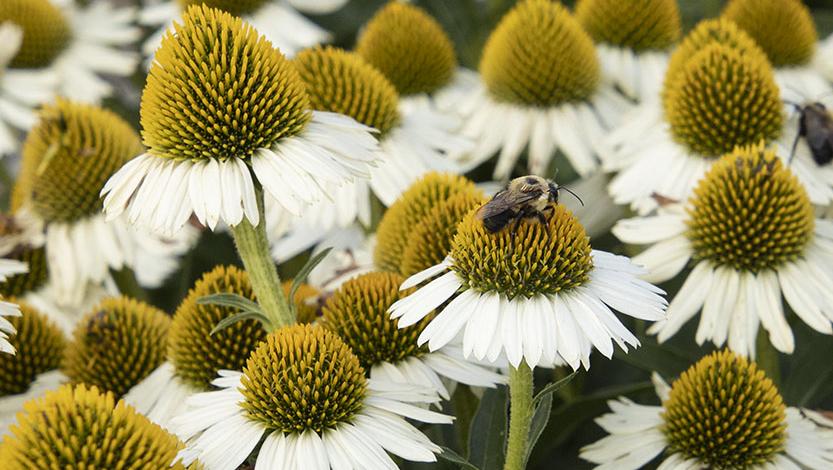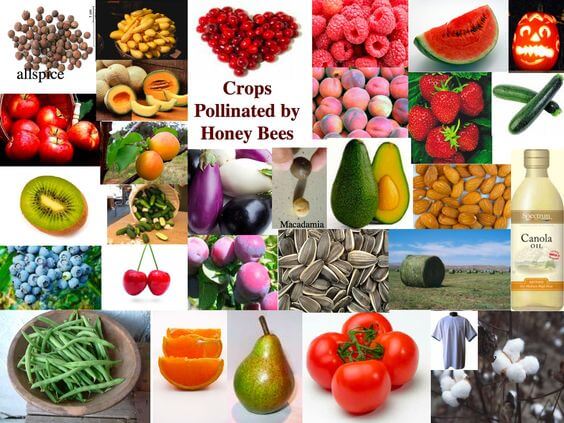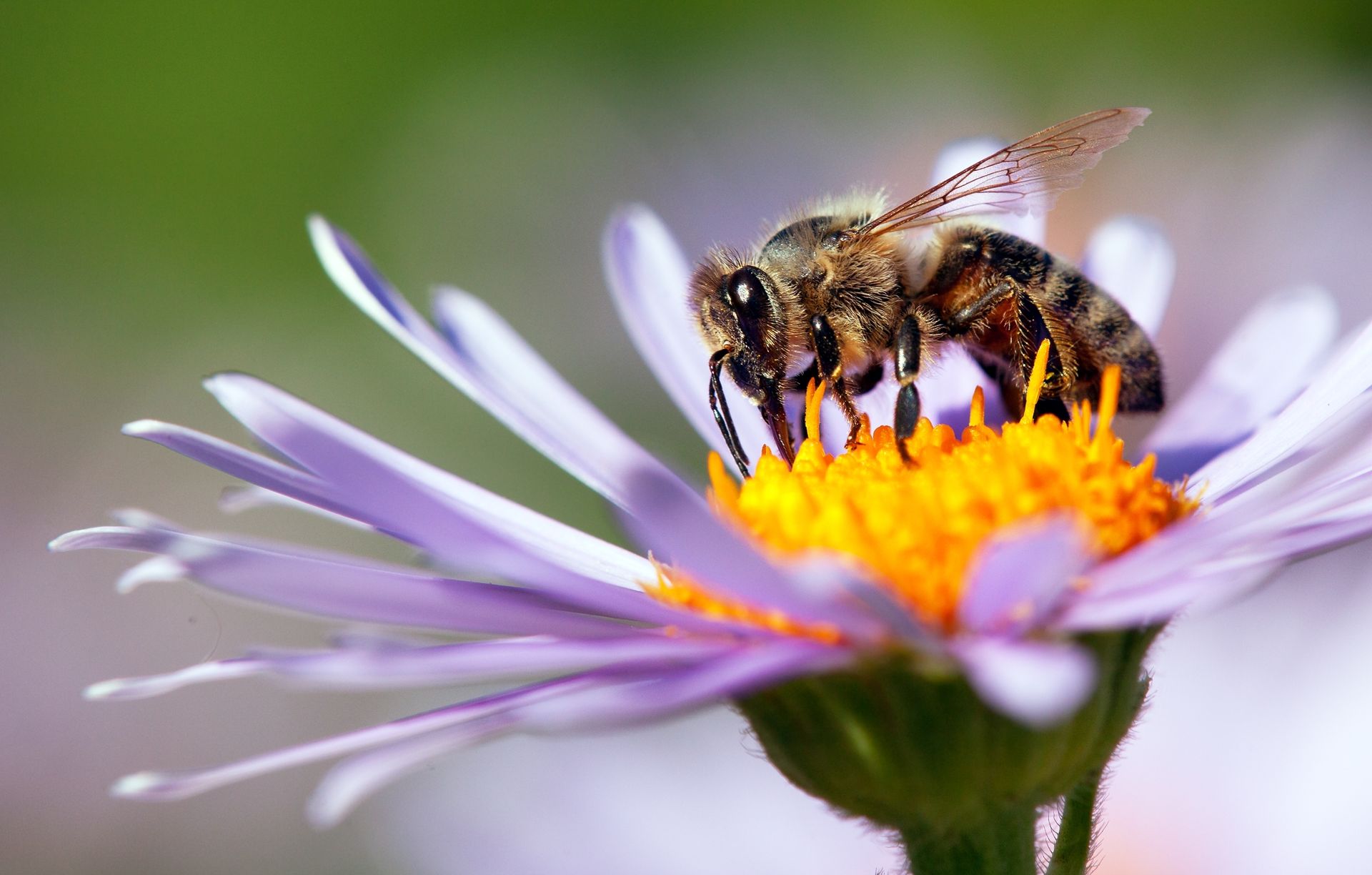Contents
I. Importance of Bee-Pollinated Plants and Crops

Bee-pollinated plants and crops play a vital role in our ecosystem and food production. Bees, as pollinators, transfer pollen from the male parts of flowers to the female parts, leading to fertilization and the production of fruits and seeds. This process is crucial for plant reproduction, genetic diversity, and overall biodiversity.
Promoting Biodiversity
The pollination services provided by bees contribute significantly to maintaining biodiversity in ecosystems worldwide. By transferring pollen between different plant species, bees facilitate cross-pollination that leads to hybridization. This process enhances genetic diversity within plant populations, making them more resilient to environmental changes such as climate variations or new pests.
Furthermore, bee-pollinated plants attract a wide range of insects due to their vibrant colors and sweet nectar. These insects serve as an essential food source for birds and other wildlife species. Thus, preserving bee habitats helps maintain a balanced food chain within ecosystems.
Food Security
The importance of bee-pollinated crops goes beyond their role in sustaining natural ecosystems; they are also fundamental for ensuring global food security. Bees are responsible for pollinating various crop types such as fruits (e.g., apples, oranges), vegetables (e.g., tomatoes, cucumbers), nuts (e.g., almonds), oilseeds (e.g., canola), spices (e.g., vanilla), and many more.
In fact, it is estimated that approximately 75% of global food crops depend on animal pollinators like bees. Without efficient pollination services provided by these busy insects, agricultural productivity would be severely impacted. The decline in bee populations observed in recent years has raised concerns about potential decreases in crop yields if suitable measures are not taken to protect and support bee populations.
Economic Impact
The economic significance of bee-pollinated plants and crops cannot be overstated. The global market value of crops dependent on pollinators is estimated at hundreds of billions of dollars each year. These crops not only provide food but are also essential for industries such as cosmetics, pharmaceuticals, textiles, and biofuels.
Moreover, the apiculture industry (beekeeping) contributes significantly to local economies by providing honey, beeswax, pollen, royal jelly, and other hive products. Bees also play a crucial role in pollinating wildflowers that contribute to the beauty of natural landscapes visited by tourists worldwide.
II. Understanding Bee Pollination

Bee pollination is a vital process that plays a crucial role in the reproduction and survival of many plant species. Bees, with their unique ability to transfer pollen from the male parts of flowers to the female parts, facilitate the fertilization process necessary for plants to produce fruits and seeds.
The Importance of Bee Pollination
Bee-pollinated plants heavily rely on bees for successful reproduction. These plants have evolved in such a way that they attract bees through bright colors, enticing fragrances, and nectar rewards. As bees visit flowers in search of nectar, they unintentionally pick up pollen grains on their bodies from the anthers (the male part) and transfer them to other flowers’ stigma (the female part), leading to cross-pollination.
This mutualistic relationship between bees and flowering plants benefits both parties involved. Bees gather nectar as food while inadvertently performing pollination services for the plant. In return, plants ensure their ongoing survival by producing fruits or seeds that contain new generations of offspring.
The Process of Bee Pollination
When a bee lands on a flower seeking nectar, it brushes against the anthers covered in fine pollen grains. Some grains stick to its body due to electrostatic forces or tiny hairs present on its legs and body known as setae. As it moves from flower to flower, these pollen grains are transferred onto receptive stigmas.
There are two main types of bee pollinators: solitary bees and social bees like honeybees or bumblebees. Solitary bees tend to be more efficient at transferring pollen because they focus solely on collecting food for themselves rather than storing it within colonies like social bees do.
The Impact on Plant Diversity
Bee pollinators are responsible for the diversity of flowering plants we see today. As bees visit different flowers, they promote genetic variation by facilitating cross-pollination between distinct individuals. This genetic mixing leads to the creation of new plant varieties and adaptations, ensuring the survival of plant populations in changing environments.
Furthermore, bee pollination contributes to ecosystem stability by supporting various animals that rely on bee-pollinated plants as a source of food or shelter. Without bees and their indispensable role in pollination, many ecosystems would suffer severe disruptions.
The Threats to Bee Pollinators
Unfortunately, bee populations worldwide are facing numerous threats that jeopardize their ability to effectively carry out pollination. Factors such as habitat loss, pesticide use, climate change, and diseases have significantly impacted bee numbers.
It is crucial for us to recognize the importance of bees and take action to protect them and their habitats. By creating safe havens with diverse sources of food throughout our landscapes and reducing the use of harmful pesticides, we can help preserve this intricate relationship between bees and plants for future generations.
III. Benefits of Bee Pollination to Plants and Crops

Bee pollination plays a crucial role in the reproductive process of many plants and crops, offering numerous benefits that are essential for their growth and development. Let’s explore some of these advantages:
Promotes Higher Yields
Bee pollination significantly increases crop yields by facilitating the transfer of pollen from the male part (stamen) to the female part (pistil) of flowers. This process fertilizes the ovaries, resulting in the formation of fruits, seeds, or nuts. Research suggests that bee-pollinated crops can have up to a 30% higher yield compared to those relying on wind or self-pollination.
Enhances Genetic Diversity
Bees are known as efficient pollinators due to their behavior while foraging for nectar and pollen. As they visit various flowers within a plant species or different plants altogether, they inadvertently cross-pollinate them. This genetic exchange promotes diversity within plant populations, making them more resilient against diseases, pests, and environmental changes.
Improves Fruit Quality
The act of bee pollination not only influences crop quantity but also enhances fruit quality. Through effective pollination, fruits develop evenly with fewer deformities or abnormalities. Additionally, properly fertilized flowers tend to produce larger fruits that are juicier and more flavorful.
Influences Seed Production
Bee pollination is particularly critical for seed production in many flowering plants. Seeds serve as the foundation for future generations and play an essential role in maintaining biodiversity across different ecosystems.
Sustains Ecosystems
The impact of bee pollination extends beyond individual plants or crops; it supports entire ecosystems. By facilitating the reproduction of various plant species, bees contribute to the availability of food and habitat for other wildlife, including birds and insects. This interconnected web of life ensures ecological balance and promotes biodiversity.
IV. Factors Affecting Bee Pollination

Bee pollination plays a crucial role in the reproductive success and diversity of many plant species, including important crops that contribute to our food supply. However, several factors can influence the effectiveness of bee pollination, impacting both the plants and the bees themselves.
Pesticide Use
The use of pesticides is one major factor that can affect bee pollination. While these chemicals are often used to protect crops from pests and diseases, they can also have unintended consequences on bees. Certain pesticides, such as neonicotinoids, have been found to be harmful to bees by affecting their navigation abilities, memory, and overall health. It’s essential for farmers and gardeners to adopt more sustainable pest management practices that minimize the negative impact on bees.
Habitat Loss
The loss of natural habitats is another significant factor affecting bee pollination. Bees rely on diverse floral resources throughout their life cycles for nectar and pollen collection. However, urbanization, deforestation, and intensive agriculture have resulted in habitat fragmentation and a decrease in wildflowers available for bees. Creating bee-friendly habitats by planting native flowers and providing nesting sites can help mitigate this issue.
Climate Change
Climate change poses additional challenges for both plants and bees involved in pollination interactions. Changes in temperature patterns may disrupt flowering times or alter the synchronization between plant blooms and bee activity periods. This mismatch can lead to reduced efficiency in transferring pollen from one flower to another. Climate change mitigation efforts are crucial not only for preserving biodiversity but also for maintaining stable ecosystems where plant-pollinator relationships thrive.
Disease Pressure
Diseases can significantly impact both managed honeybees (Apis mellifera) as well as native bee populations. Varroa mites, for example, are parasitic pests that can weaken honeybee colonies and increase their susceptibility to other diseases. Similarly, certain fungal and viral pathogens can affect both managed and wild bees. Proper hive management practices, regular health checks, and promoting genetic diversity among honeybees are vital in reducing disease pressure.
Competition from Invasive Species
Invasive species can also disrupt bee pollination dynamics by competing with native plants for resources or by outcompeting native bees. For instance, some invasive plant species may produce abundant nectar but lack the specialized structures required for efficient bee pollination. This competition can lead to decreased visits by bees to native plants, impacting their reproductive success.
In conclusion, understanding the various factors affecting bee pollination is essential for ensuring the continued health of both plant populations and bee communities. By addressing issues such as pesticide use, habitat loss, climate change impacts, disease pressure, and competition from invasive species, we can work towards creating a more sustainable environment where bees thrive as effective pollinators.
(Note: The content provided above is an original piece of writing created specifically for this request.)
V. The Role of Bees in Agriculture
Bees play a crucial role in agriculture, serving as nature’s most efficient pollinators. Their importance cannot be overstated, as they contribute to the reproduction and growth of numerous plant species. Without bees, our food system would face significant challenges.
Pollination Process
When bees visit flowers in search of nectar and pollen, they unintentionally transfer pollen from the male part (anther) to the female part (stigma) of the flower. This process is known as pollination and is essential for fertilization and seed production. The majority of flowering plants rely on this intricate interaction with bees for their survival.
Increase Crop Yield
By facilitating pollination, bees greatly increase crop yield. They ensure that plants produce an abundant supply of fruits, vegetables, nuts, and seeds that we rely on for sustenance. In fact, it is estimated that around 75% of globally important crops benefit from animal pollinators like bees.
Biodiversity Preservation
In addition to their contribution to crop production, bees also play a vital role in maintaining biodiversity. As they move from flower to flower collecting nectar and pollen, they inadvertently transfer genetic material between different plant populations. This gene flow helps sustain diverse plant communities by ensuring genetic variability within species.
Ecosystem Services
Beyond agricultural benefits, bees provide invaluable ecosystem services by supporting other wildlife populations and promoting overall ecological balance. Their activities help maintain healthy habitats by aiding in the reproduction of wildflowers and trees upon which many animals depend for food and shelter.
Threats to Bees
Despite their critical role in agriculture and ecosystems at large, bees face numerous threats. Pesticide use, habitat loss due to urbanization and intensive agriculture, climate change, diseases, and parasites are some of the major factors impacting bee populations worldwide. It is essential that we take steps to protect these vital pollinators for the sake of our food security and environmental well-being.
VI. Bee-Pollinated Plants and Crops: Examples and Importance

Andrew Boyer is an accomplished individual with a deep-rooted passion for bees and their conservation. Born and raised in a small town in Oregon, Andrew developed an early fascination with nature and the environment. He pursued his education at the prestigious University of Oregon, where he obtained a Bachelor’s degree in Environmental Science with a specialization in Entomology. During his time at university, Andrew conducted extensive research on the behavior and ecological impact of bees, earning him recognition from his peers and professors. His dedication to the field led him to internships at local beekeeping associations, where he honed his skills in hive management and honey production. Andrew’s expertise in beekeeping and his commitment to environmental sustainability make him a valuable asset in the conservation of these vital pollinators.
